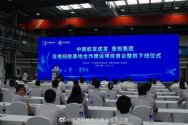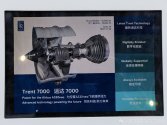Just got this 察话会au podcast hosted by Yankee & Co. two days ago, which generally discussed about domestic aircraft engine development progress for the C919 and C929, and the looking forward to the future development of large aircraft.
Key points summed up from the podcast, listed by a comment:
Roughly translated:
- (CJ-1000)AX is larger than (CJ-1000)A, and (CJ-1000)AX can be said as a practice project (14 tons of thrust);
- It (CJ-1000/A) includes foreign components and a large number of products from domestic factories and institutes;
- The engine being tested on the Y-20 flight test platform is the CJ-1000;
- ACAE plans to develop the nacelle (for the CJ-1000/A) on its own;
- Certification (of the CJ-1000) is expected in 2030;
- The progress of CJ-2000 is relatively faster compared to CJ-1000;
- Both CJ-1000 and CJ-2000 extensively use composite materials, including but not limited to the intake and blades;
- The composite material blades are fully impregnated and pressed with resin, resembling a bee-waxy texture in appearance, with metal edges (possibly titanium alloy) on the leading edge of the blades. The first generation features hollow all-metal titanium alloy blades, and is only slightly heavier than the composite version;
- CJ-2000 is in the demonstrator stage and has already undergone thrust testing. The prototype will be seen by the end of this year;
- The progress of the Russian PD-35 engine is relatively (in not considerably) behind that of the CJ-2000;
- The current perception of ACAE is that it operates like a large-scale Ph.D. station, engaging in comprehensive forward-looking research through exploration. It is actively expanding and placing a strong emphasis on laboratory construction, with a huge test workshop measuring 14 meters by 14 meters;
- ACAE's experimental conditions have the latecomer advantages, and it can even assist with the tasks of the AECC;
- The fuel consumption of the CJ-1000A is slightly higher than the Leap-1C, while the noise level is slightly lower (according to the display board comparison);
- Test flights of the CJ-1000 version of the C919 are expected to begin around 2027-2028;
- The C919 has a design for a fully domestically-produced version (potentially aligning with the 2027 timeline, which serves as a political deterrent against potential sanctions);
- The foreign engine for the C929 has not yet been announced. The CJ-2000 (with a thrust of 33 tons) is compared with the GEnx (34 tons of thrust, the engine for the Boeing 787) on the display board;
- It is estimated that the first C929 will be rolled out in 2029; and
- It is estimated that the progress of CJ-2000 is faster than that of the CJ-1000 by 3-4 years. By the end of the C929 certification, the CJ-2000 will be ready and can begin the certification process on the C929.
with due respect to Yankee & Co.. there are many outdated and wrong information in this discussion. let me clear one by one.
It (CJ-1000/A) includes foreign components and a large number of products from domestic factories and institutes
this is the topic we have discuss before many times..
CJ-1000 engine high end nut , bolt , and especially Bearings have been imported from a Scandinavian country.. this was during 2021. i have had long discussion with my source on this..
---------------------------------------------------------------
Beijing Institute of Aeronautical Materials exceeded 50,000 hours, marking a new breakthrough in my country's high-end equipment manufacturing technology.
The key component of the fatigue test was the main bearing of an aero-engine independently developed by my country. It did not fail in the equivalent accelerated fatigue life of 50,000 hours on the tester, setting a new record in my country.
------------------------------------------------------------
so there is high possibility that those imported Bearings have replaced with domestic one already.
i m repeating again, all core components of CJ-1000 ENGINE are domestically produced.
high pressure compressor
Combustion chamber (it is 3D printed design)
High pressure turbine/blades/disk
Wuxi city has many core suppliers in CJ-1000A engine. blades/turbine disk/rotor bearings/FADEC are produced in this city.
ACAE plans to develop the nacelle (for the CJ-1000/A) on its own;
AECC Shangfa successfully developed CJ-1000A nacelle already.. back in 2022. i m posting the link as well
so this is completely wrong that, they are planning to develop.. its already developed and manufactured.
---------------------------------------------------------------------------------------
Nacelle reverse thruster also successfully developed by AECC Chengdu

Nacelle+reverse thruster complete set have successfully developed.
Certification (of the CJ-1000) is expected in 2030
Certification will be completed before 2030..
The foreign engine for the C929 has not yet been announced. The CJ-2000 (with a thrust of 33 tons) is compared with the GEnx (34 tons of thrust, the engine for the Boeing 787) on the display board;
Zhuhai air show 2022, COMAC display Trent700 ENGINE alongside C929..

not saying, this is 100 percent confirmed but COMAC intent to use Trent700 in first C929 flight.. though there is a strong chance that, CJ-2000 will catch up C929 development..
CJ-2000 total thrust will be 78,000+ lbf.. exceed 35 tons. officially confirmed by AECC..




